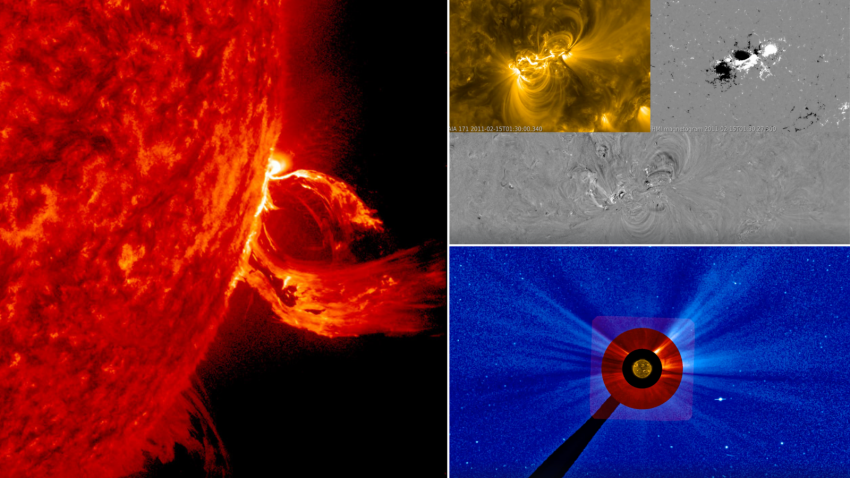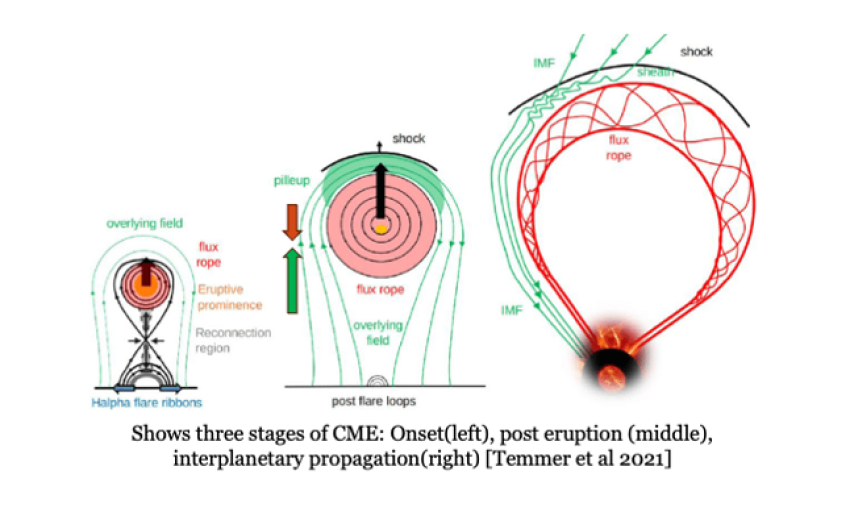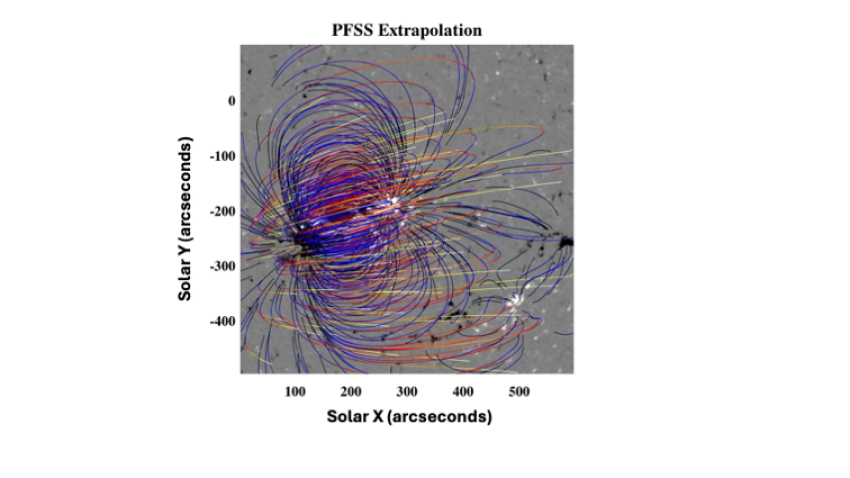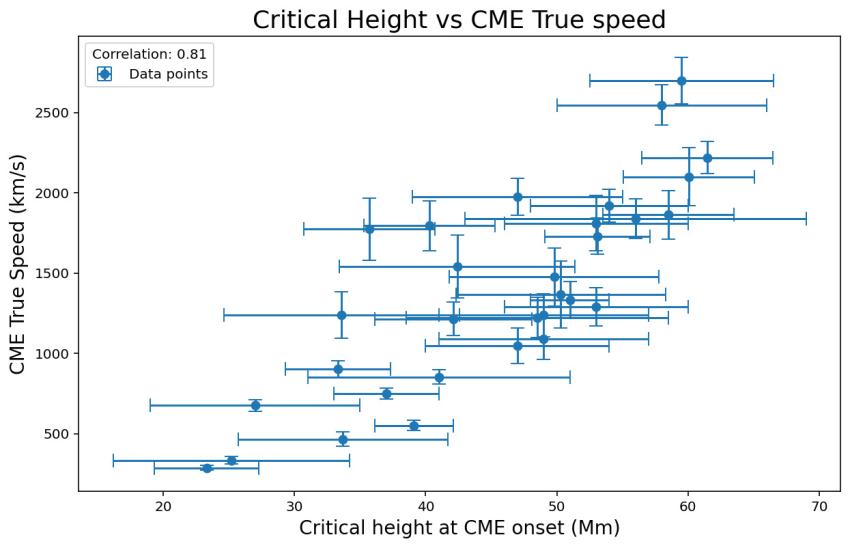Space storms could soon be forecasted with greater accuracy than ever before thanks to a big leap forward in our understanding of exactly when a violent solar eruption may hit Earth.
Scientists say it is now possible to predict the precise speed a coronal mass ejection (CME) is travelling at and when it will smash into our planet – even before it has fully erupted from the Sun.
CMEs are bursts of gas and magnetic fields spewed into space from the solar atmosphere.
They can cause geomagnetic storms that have the potential to wreak havoc with terrestrial technology in Earth's orbit and on its surface, which is why experts across the globe are striving to improve space weather forecasts.
Advancements such as this one could make a huge difference in helping to protect infrastructure that is vital to our everyday lives, according to researchers at Aberystwyth University, who will present their findings today at the Royal Astronomical Society's National Astronomy Meeting in Hull.
They made their discovery after studying specific areas on the Sun called 'Active Regions', which have strong magnetic fields where CMEs are born. The researchers monitored how these areas changed in the periods before, during and after an eruption.
A vital aspect which they looked at was the "critical height" of the Active Regions, which is the height at which the magnetic field becomes unstable and can lead to a CME.
"By measuring how the strength of the magnetic field decreases with height, we can determine this critical height," said lead researcher Harshita Gandhi, a solar physicist at Aberystwyth University.
"This data can then be used along with a geometric model which is used to track the true speed of CMEs in three dimensions, rather than just two, which is essential for precise predictions."
She added: "Our findings reveal a strong relationship between the critical height at CME onset and the true CME speed.
"This insight allows us to predict the CME's speed and, consequently, its arrival time on Earth, even before the CME has fully erupted."
Explanation: Using the above plot for prediction requires a robust statistical or machine learning model that accounts for uncertainties and other influencing factors beyond just the critical height. This plot alone does not provide a complete predictive model for new active regions. The critical height and onset conditions might change rapidly over time, and new active regions could evolve differently compared to historical data. While the plot provides valuable insights and a strong correlation between critical height and CME speed, predicting CME speeds in new active regions requires caution. A more comprehensive model incorporating additional parameters and uncertainties is necessary for reliable predictions. Therefore, the plot can be a useful component in a predictive framework, but it should not be the sole basis for predicting CME speeds in new active regions.
When these CMEs hit the Earth they can trigger a geomagnetic storm which is capable of producing stunning aurorae, often referred to in the northern hemisphere as the Northern Lights.
But the storms also have the potential to disrupt vital systems we rely on daily, including satellites, power grids, and communication networks, which is why scientists worldwide are working hard to improve our ability to better predict when CMEs will hit Earth.
This requires knowing a more accurate speed of the CME shortly after it erupts from the Sun to better provide advance warnings of when it will reach our planet.
Accurate speed predictions enable better estimates of when a CME will reach Earth, providing crucial advance warnings.
"Understanding and using the critical height in our forecasts improves our ability to warn about incoming CMEs, helping to protect the technology that our modern lives depend on," Gandhi said.
"Our research not only enhances our understanding of the Sun's explosive behaviour but also significantly improves our ability to forecast space weather events.
"This means better preparation and protection for the technological systems we rely on every day."
Media contacts
Sam Tonkin
Royal Astronomical Society
Mob: +44 (0)7802 877 700
Dr Robert Massey
Royal Astronomical Society
Mob: +44 (0)7802 877 699
Megan Eaves
Royal Astronomical Society
Science contacts
Harshita Gandhi
Aberystwyth University
Images and captions
Caption: A coronal mass ejection is seen erupting from the Sun in June 2015.
Credit: NASA Goddard Space Flight Center
Caption: This clip shows the before, during and post eruption state of the Active Region AR11158, with the top left panel showing the AR in 171 wavelength, the top right panel a cutout of HMI magnetogram and the bottom panel a running difference movie.
Credit: Jhelioviewer
Caption: This clip shows a coronal mass ejection which erupted from AR11158 on its way to Earth, moving outwards in LASCO c2 and c3 field of view.
Credit: Jhelioviewer
Caption: The different stages of a coronal mass ejection, from onset (left), to post-eruption (middle) and travel towards objects like Earth in our solar system (right).
Credit: Temmer et al. 2021
Caption: Magnetic field lines at different heights above the photosphere extrapolated using Greens function approach as seen from top to bottom.
Credit: Harshita Gandhi
Caption: Scatter plot illustrating the relationship between Critical Height at CME onset and CME True Speed. Each data point represents an individual CME event, with error bars. The plot reveals a positive strong correlation (r = 0.81) between the critical height (Mm) at CME onset and the true speed of the CME (km/s), suggesting that higher critical heights at onset are associated with faster CMEs.
Credit: Harshita Gandhi
Notes for editors
The NAM 2024 conference is principally sponsored by the Royal Astronomical Society, the Science and Technology Facilities Council and the University of Hull.
About the Royal Astronomical Society
The Royal Astronomical Society (RAS), founded in 1820, encourages and promotes the study of astronomy, solar-system science, geophysics and closely related branches of science.
The RAS organises scientific meetings, publishes international research and review journals, recognises outstanding achievements by the award of medals and prizes, maintains an extensive library, supports education through grants and outreach activities and represents UK astronomy nationally and internationally. Its more than 4,000 members (Fellows), a third based overseas, include scientific researchers in universities, observatories and laboratories as well as historians of astronomy and others.
The RAS accepts papers for its journals based on the principle of peer review, in which fellow experts on the editorial boards accept the paper as worth considering. The Society issues press releases based on a similar principle, but the organisations and scientists concerned have overall responsibility for their content.
Keep up with the RAS on X, Facebook, LinkedIn and YouTube.
About the Science and Technology Facilities Council
The Science and Technology Facilities Council (STFC) is part of UK Research and Innovation – the UK body which works in partnership with universities, research organisations, businesses, charities, and government to create the best possible environment for research and innovation to flourish.
STFC funds and supports research in particle and nuclear physics, astronomy, gravitational research and astrophysics, and space science and also operates a network of five national laboratories, including the Rutherford Appleton Laboratory and the Daresbury Laboratory, as well as supporting UK research at a number of international research facilities including CERN, FERMILAB, the ESO telescopes in Chile and many more.
STFC's Astronomy and Space Science programme provides support for a wide range of facilities, research groups and individuals in order to investigate some of the highest priority questions in astrophysics, cosmology and solar system science.
STFC's astronomy and space science programme is delivered through grant funding for research activities, and also through support of technical activities at STFC's UK Astronomy Technology Centre and RAL Space at the Rutherford Appleton Laboratory. STFC also supports UK astronomy through the international European Southern Observatory and the Square Kilometre Array Organisation.
Visit https://stfc.ukri.org/ for more information. Follow STFC on Twitter: @STFC_Matters
About the University of Hull's E.A. Milne Centre
The E.A. Milne Centre for Astrophysics at the University of Hull brings together experts who study the evolution of structure in the Universe ranging from stars through to galaxies and galaxy clusters, right up to the largest structures in the cosmos.
The centre employs observations, theory and computational methods in collaboration with international partners. Postgraduate and undergraduate students work alongside staff to understand the wonders of the Universe. Through a series of outreach activities, the centre also aims to share its passion for astronomy and astrophysics with the region and beyond.





